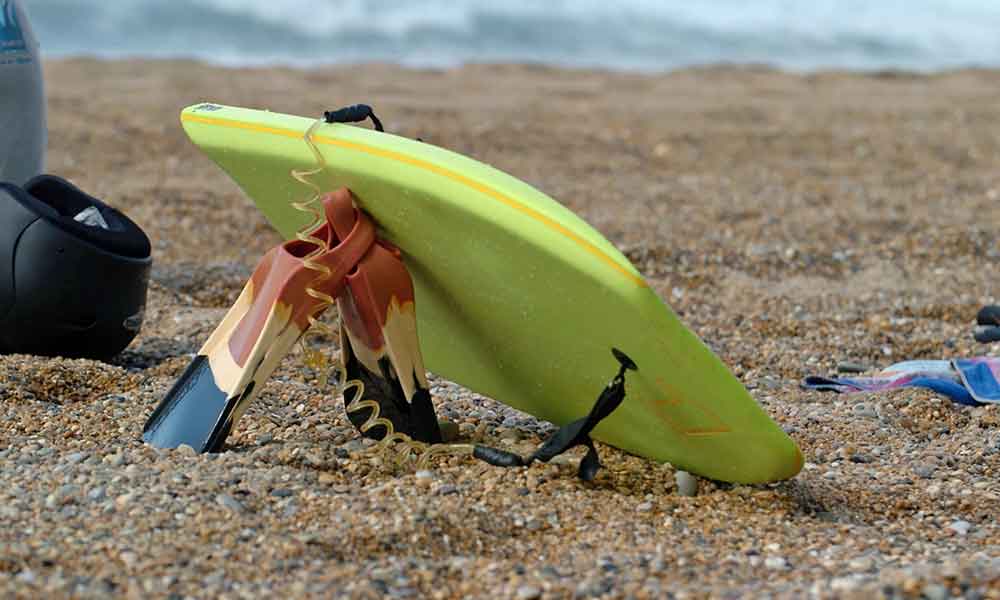Swim fins are a must for dedicated bodyboarders. But if you’re wearing them day-in-day-out and for several hours at a time, they can dig into your heels, rub against your feet, and leave you with painful cuts and sores.
Why Do Swim Fin Cuts and Sores Occur?
Swim fins are designed to be aerodynamic and to fit snug against your feet. Comfort is not the top priority and as the material constantly rubs against the skin on your feet, it can lead to sores and cuts.
Some of the issues that can make these abrasions worse include:
- Having sensitive skin
- Getting bits of sand stuck inside the fins
- Boarding/swimming in extremely cold temperatures
- Wearing low-quality swim fins
- Wearing the fins for a long time
Experience also comes into it. Just as your fingers get tougher when you play guitar, the skin on your heels, toes, and the tops of your feet will harden the more than you wear fins.
Still, that doesn’t mean you need to endure the sores and cuts. There are ways to treat them and prevent them.
How To Prevent Skin Irritation When Wearing Fins
There are a few things you can do to prevent swim fin cuts and irritation:
Wear Fin Socks
Fin socks are thin socks made from neoprene; a synthetic rubber also used to make wetsuits.
Neoprene socks create a barrier between your feet and your fins. They protect the parts of your foot that the swim fins cover, limiting the risk of chafing and pinching.
When purchasing neoprene socks, pay attention to the thickness, as well as the quality. You may also need to adjust the size of your swim fits, although the socks are only a couple of millimeters thick so it’s generally not a huge problem.
Use Lubricant
Lubricants like petroleum jelly or Belly Jelly (available from Amazon) can be applied onto bare feet before you slip on your swim fins. They prevent the friction that can lead to irritation and painful blisters. It won’t last forever, of course, but it will cover you for a large part of your session and should provide adequate protection.
Paddle With Your Arms
The more that you kick with your swim fins, the more friction you’ll create. To prevent such issues, try paddling more with your arms. It’s not the most practical option, but it works if your feet are hurting and you need to finish the session.
Wear Booties
Booties, like fin socks, are made from neoprene. They are thicker, stronger, and will keep your feet warm. They also cover more of your foot, stretching above your ankle.
Booties are perfect if your feet get very cold, but they will definitely necessitate roomier swim fins.
Get Fins That Fit
If your feet are being rubbed raw in a matter of minutes, the issue might be with your fins and not your feet.
Fins that fit too snuggly will dig in, and as they move around and generate all that friction, they’ll your flesh.
Don’t go too loose, though. Loose fins can chafe as they move around.
Buy a new pair of fins—it could make all the difference!
How Do I Stop My Flippers From Rubbing?
You can use the methods outlined above to stop your fins from rubbing against your feet and causing sores and cuts. Use the one that is most comfortable for you.
How Tight or Loose Should Swim Fins Be?
If you can fit a couple of fingers down the side of your fins, they are too loose. You might think that this will protect you, but it will actually make the situation worse, causing the fins to move around and irritate your skin.
If they are only slightly loose, try wearing some socks or booties.
The best way to determine if your fins are too tight is to try them on and test them in the water. Give them a kick and see how comfortable they are. You will know when they are too tight and when they are just right.
How To Treat Fin Rub
Prevention is the best cure, but if it’s too late and you already have cuts, sores, and blisters, it’s time to treat them!
The first step is to clean the area around the wound, making sure there is no sand or dirt that could enter the open wound and cause an infection. Clean water will suffice for these. Don’t use any harsh chemicals as you don’t want to get anything in the wound.
When the wound is clean, apply an antiseptic pad or cream. From there, you just need to keep the area clean and dry and let the antiseptic do its thing.
Your body is pretty adept at healing, but not if you slip those fins back on and return to the water. So, for particularly troublesome wounds, stay out of the water and keep the area protected at all times.







